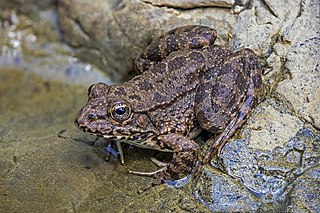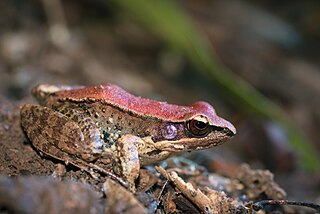
The true frogs, family Ranidae, have the widest distribution of any frog family. They are abundant throughout most of the world, occurring on all continents except Antarctica. The true frogs are present in North America, northern South America, Europe, Africa, and Asia. The Asian range extends across the East Indies to New Guinea and a single species has spread into the far north of Australia.

Indosylvirana aurantiaca, commonly known as the golden frog, is a species of frog endemic to the Western Ghats of India. The species is also known as the Trivandrum frog, the common wood frog, or the small wood frog.
The central Kashmir vole is a species of rodent in the family Cricetidae. It is found only in India and Pakistan.

Sylvirana cubitalis is a species of frog in the family Ranidae. It is found in Myanmar, Thailand, Laos, China, and possibly Vietnam.

The common green frog is a frog species of in the true frog family Ranidae; some sources still use the old name Rana erythraea. It lives in Southeast Asia and is also known as green paddy frog, red-eared frog or leaf frog. The last name, however, commonly refers to the Neotropical tree frogs which make up the subfamily Phyllomedusinae. These are not closely related to H. erythraea, belonging to family Hylidae instead.

Sylvirana faber is a species of frog in the family Ranidae. It is found in Cambodia and possibly Thailand.

Hylarana guentheri is a species of frog in the family Ranidae. It was formerly placed in the genus Rana. It is found in China, Hong Kong, Macau, Taiwan, Vietnam, and possibly Cambodia and Laos. An introduced population is found on Guam. An alternate common name is Günther's Amoy frog, and the honorific is often spelled "Guenther's".
Sylvirana maosonensis is a species of frog in the family Ranidae. It is found in the mountains of central and northeastern in Vietnam, Annamite Range in central Laos, and southern Guanxi, China. Its common name is Mao-Son frog or Maoson frog, after its type locality in Vietnam. It inhabits evergreen forests at elevations of 200–1,500 m (660–4,920 ft) above sea level. Individuals are typically found near streams on banks, leaf litter, and low in vegetation. Reproduction takes place in streams, ponds, and ditches. It is a locally common frog. Although International Union for Conservation of Nature (IUCN) does not considered it threatened as a species, habitat loss and degradation are threats.

Pelophylax is a genus of true frogs widespread in Eurasia, with a few species ranging into northern Africa. This genus was erected by Leopold Fitzinger in 1843 to accommodate the green frogs of the Old World, which he considered distinct from the brown pond frogs of Carl Linnaeus' genus Rana.

Sylvirana nigrovittata, also known as the black-striped frog, black-spotted stream frog, sapgreen stream frog, etc., is a species of frog in the family Ranidae. It is found in northeastern India, Bangladesh, Nepal, southern China, Myanmar, Thailand, Cambodia, Laos, and Vietnam. The species was redelimited in 2018, and earlier literature may refer to other species; identifications from India and Bangladesh are still uncertain.

Hylarana, commonly known as golden-backed frogs, is a genus of true frogs found in tropical Asia. It was formerly considered highly diverse, containing around 84 to 96 valid species, but taxonomic revision resulted in a major change in the contents of the genus, and today it is recognised as containing just four species.

Sylvirana is a genus of true frogs, family Ranidae, found in South and East Asia, from northeastern India in west to China in the north, Taiwan in the east, and Thailand in the south. Originally proposed as a subgenus of Rana in 1992, it has been considered both a full genus and a synonym of Hylarana. Its current recognition at generic level stems from molecular genetic analyses published in 2015.
Pulchrana debussyi is a species of true frog, family Ranidae. It is endemic to Sumatra, Indonesia. It is only known from its type locality in the Batak Mountains. The holotype is now lost, and there are concerns about validity of this taxon—it might be a synonym of Sylvirana nigrovittata. Common name Battak frog has been proposed for it.

Sylvirana mortenseni is a species of true frog. It is found in Cambodia, Laos, and Thailand. The specific name mortenseni honours Ole Theodor Jensen Mortensen, the Danish zoologist who collected the holotype from the island of Koh Chang. Common names Mortensen's frog and Koh Chang Island frog have been proposed for it.
Hylarana spinulosa, also known as fine-spined frog and spiny frog, is a species of true frog, family Ranidae. It is endemic to Hainan, southern China. It occurs in tropical forests at elevations of 80–840 m (260–2,760 ft) above sea level. Breeding takes place in pools and slow-flowing streams.
Ole Theodor Jensen Mortensen, also known as Theodor Mortensen was a Danish scientist and professor at the Zoological Museum, Copenhagen. He specialized in sea urchins (Echinoidea) and provided an enormous marine collection to the museum. He collected many sea urchin species on his expeditions between 1899–1930.








